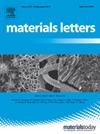作为锂离子电池高性能负极的 SiO2/C 双层涂层 SiO
IF 2.7
4区 材料科学
Q3 MATERIALS SCIENCE, MULTIDISCIPLINARY
引用次数: 0
摘要
作为锂离子电池的负极,一氧化硅(SiO)具有很高的理论容量,但其较差的导电性和体积效应会导致容量骤降。将二氧化硅与其他材料结合,在二氧化硅表面形成核壳机制,可以有效缓解这些问题。在这项研究中,针对核壳结构固有的问题,设计并合成了一种涂覆在 SiO 阳极材料上的二氧化硅(SiO2)/碳(C)双层核壳结构。当温度为 900 °C 时,SiO@SiO2@C 显示出 2500.08 mAh-g-1 的出色可逆容量和 75.92 % 的第一库仑效率。经过 100 次充放电循环后,仍能保持 1298.25 mAh-g-1 的容量。与纯氧化硅相比,它的循环稳定性和容量保持率都有显著提高,为锂离子电池的负极材料提供了一种新方法。本文章由计算机程序翻译,如有差异,请以英文原文为准。
SiO2/C double-layer-coated SiO as a high-performance anode for lithium-ion batteries
Silicon monoxide (SiO) has a high theoretical capacity as an anode for lithium-ion batteries, but its poor conductivity and bulk effect can cause the capacity to plummet. The combination of SiO and other materials to form a core–shell mechanism on the surface of SiO can effectively alleviate these problems. In this work, a silicon dioxide (SiO2)/carbon (C) bilayer core–shell structure coated on SiO anode material was designed and synthesized to address the issues inherent in core–shell structures. When the temperature was 900 °C, SiO@SiO2@C exhibited an excellent reversible capacity of 2500.08 mAh·g−1 and a first coulombic efficiency of 75.92 %. After 100 charge/discharge cycles, it still retained 1298.25 mAh·g−1 of its capacity. Compared with those of pure SiO, its cycling stability and capacity retention are significantly improved, providing a new approach for anode materials in lithium-ion batteries.
求助全文
通过发布文献求助,成功后即可免费获取论文全文。
去求助
来源期刊

Materials Letters
工程技术-材料科学:综合
CiteScore
5.60
自引率
3.30%
发文量
1948
审稿时长
50 days
期刊介绍:
Materials Letters has an open access mirror journal Materials Letters: X, sharing the same aims and scope, editorial team, submission system and rigorous peer review.
Materials Letters is dedicated to publishing novel, cutting edge reports of broad interest to the materials community. The journal provides a forum for materials scientists and engineers, physicists, and chemists to rapidly communicate on the most important topics in the field of materials.
Contributions include, but are not limited to, a variety of topics such as:
• Materials - Metals and alloys, amorphous solids, ceramics, composites, polymers, semiconductors
• Applications - Structural, opto-electronic, magnetic, medical, MEMS, sensors, smart
• Characterization - Analytical, microscopy, scanning probes, nanoscopic, optical, electrical, magnetic, acoustic, spectroscopic, diffraction
• Novel Materials - Micro and nanostructures (nanowires, nanotubes, nanoparticles), nanocomposites, thin films, superlattices, quantum dots.
• Processing - Crystal growth, thin film processing, sol-gel processing, mechanical processing, assembly, nanocrystalline processing.
• Properties - Mechanical, magnetic, optical, electrical, ferroelectric, thermal, interfacial, transport, thermodynamic
• Synthesis - Quenching, solid state, solidification, solution synthesis, vapor deposition, high pressure, explosive
 求助内容:
求助内容: 应助结果提醒方式:
应助结果提醒方式:


